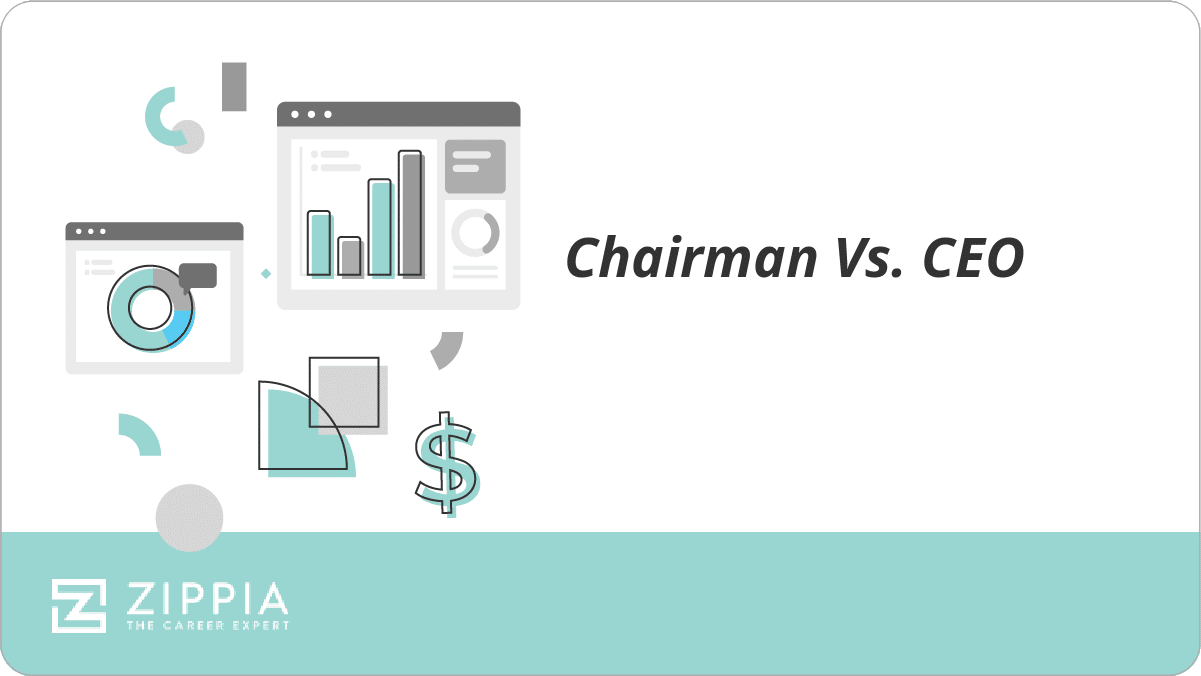- Job Comparisons
- Jobs With Perks
- Fields
- By Field
- Collar Jobs
Find a Job You Really Want In
When you hear about positions of leadership in companies, you’ll likely hear about the chairman of the board and the CEO. These two individuals are both at the forefront of the organization’s mission and strategies, but what is the difference between the two roles?
To answer this question, we’ll go over each position’s responsibilities and highlight the differences between a chairman and a CEO in this article.
Key Takeaways
-
A chairman is the head of a company’s board of directors.
-
A CEO is the head of the company’s internal leadership structure.
-
The board of directors appoints the CEO, and the chairman and CEO work together to lead the company.

What Is a Chairman?
A company’s chairman is the head of its board of directors. They are elected by the board to protect investors’ interests. Shareholders elect a board of directors to represent them. Every public company must have a board of directors, while private and nonprofit organizations may or may not have one.
A board of directors has the following responsibilities:
-
Establish management policies
-
Ensure the company’s stability and profitability
-
Handle structural issues within the company
-
Set long-term objectives
-
Approve annual budgets
-
Set salaries and benefits
-
Direct dividend policy
-
Recruit, appoint, and evaluate CEO
-
Meet at least quarterly to vote on major strategic decisions
The board of directors holds the ultimate decision-making authority in the company. The board of directors is typically composed of both internal and external members, representing both managerial and shareholder interests.
As the head of the board, the chairman is an executive who wields substantial power. The chairman acts as a senior representative of shareholders, meaning their role is essentially ensuring the company is maximizing profits. In a real-world setting, the board of directors needs to balance short-term profitability goals with long-term stability.
Notably, a chairman does not have managerial oversight over other members of the board. All board members are considered peers, so the board’s decisions are not solely the chairman’s. However, a chairman has the following responsibilities:
-
Set the agenda for board meetings
-
Ensure board meetings run smoothly and achieve a consensus on decisions
-
Hold votes on key strategic policies offered by the CEO
-
Hire and fire executives, including the CEO and president
-
Monitor the overall profitability, sustainability, and growth of the company
The chairman has significant clout in deciding how the board votes. However, they do not play an active role in managing the company’s day-to-day operations. Just as every company is different, so is every company’s chairman.
Some take a more hands-on approach, while others allow senior executives, like the CEO, considerable flexibility in carrying out their functions. Ultimately, though, the board of directors, with the chairman as their lead representative, acts as the CEO’s superior and serves as a check on any major policy decisions they offer.
What Is a CEO?
A CEO is a company’s top decision-maker who establishes strategic processes and ensures that progress is made toward corporate objectives. The CEO position is the highest rung on the corporate ladder, and all other executives answer to him or her. A CEO delegates tactical responsibilities involving day-to-day operations to other managers. They also have the authority to overrule managers’ decisions when deemed necessary.
Think of the CEO as the ultimate big-picture person who develops a broad corporate vision. It’s not enough to come up with stellar ideas, though. A CEO has to communicate their vision to a host of characters, including investors, management, lower-level employees, and the board of directors. Without this communication, key initiatives would never get off the ground.
A CEO has the following responsibilities:
-
Oversee departmental managers, and overrule their decisions when necessary
-
Develop and communicate the company’s vision, policies, and strategies
-
Handle strategic issues like:
-
Act as the “face” of the company by:
-
Directing public relations
-
Maintaining investor relationships
-
Attending and presenting at conferences
-
-
Select other senior executives
-
Drum up further investments
-
Update the board of directors with timely, thorough information
-
Identify opportunities for growth
-
Establish and maintain a company culture
-
Monitor company’s finances
-
Align the company’s budget with corporate goals
-
Implement decisions made by the board of directors
As you can see, a CEO holds substantial authority in determining their company’s policies and actions. Note that, while CEOs hold other executives accountable, the CEO is held responsible by the board of directors.
A CEO is ultimately responsible for a company’s success or failure. It is their job to ensure that issues are met with appropriate responses and that the business is on the right track.
Differences Between Chairman and CEO Positions
The chairman of a company’s board of directors is superior to the CEO. A company’s CEO must seek board approval to make any significant decisions. As head of the board, the chairman holds considerable sway over how the board votes on decisions proposed by the CEO.
Typically, however, a company’s CEO and chairman work together to co-lead the company. They discuss issues and the corporation’s overarching vision, and the chairman decides how much flexibility the CEO has in implementing new strategies. Ultimately, though, the board has the final say and can hire and fire CEOs as they see fit.
However, this explanation comes with a pretty massive grain of salt. CEOs are typically in charge of appointing departmental managers, who, in some companies, are automatically made members of the board. By having a say over some board members, the CEO also has the power to determine who will oversee and evaluate their work. It depends on a company’s bylaws whether this is how the board’s composition is decided.
The balance of power between chairman and CEO varies from company to company, even within the same industry. A more active chairman can effectively become the head boss of an organization. Most chairmen, however, take a more hands-off approach and leave the company’s management to the CEO.
To break it down:
-
A CEO can overrule the decisions of other high-level executives
-
The board (headed by the chairman) can overrule the CEO’s decisions
-
A CEO is above other executives in terms of corporate hierarchy
-
A chairman is not above other members of the board; they are peers
-
A CEO is selected by the board of directors, who can also fire them
-
A chairman is selected by the board of directors, who can also fire them
There’s also a significant difference in the goals and activities of chairmen and CEOs. CEOs usually come from a background of top-level practical leadership where they’re deeply involved in the company’s operations and strategy. Chairmen typically come from an advisory background where they’re removed from the tasks that they recommend.
While the positions of chairman and CEO are distinct, they generally share the same goals and work in tandem to achieve them. Both are top-level leadership positions with a focus on keeping the corporation profitable and stable. They both focus on gaining a competitive advantage and a larger market share.
Can a Chairman and CEO Be the Same Person?
Yes, the chairman of a company can also be its CEO. This arrangement is common in founder-led companies, like Facebook. In this case, the founder is the primary shareholder and thus a natural fit for chairman. Who better to protect investors’ interests than the top shareholder, after all?
While no laws prohibit a chairman from also being the CEO or vice versa, it is generally seen as a bad idea, fraught with potential conflicts of interest. After all, a CEO must seek approval from the chairman. If the two are one and the same, then the CEO essentially has no check on their power. Of course, other board members can dissent from the CEO’s thinking, but as we’ve said, the chairman has significant clout in determining board votes’ outcomes.
Here are some other arguments for separating the positions of chairman and CEO:
-
The positions of CEO and chairman are both full-time. An individual will have difficulty performing both functions well.
-
The board of directors evaluates the CEO’s performance and sets salaries for senior-level executives, all but ensuring a conflict of interest.
-
An independent chairman is more likely to identify areas where the company is drifting from the board’s mandate and correct those issues.
-
Audit committees are required by law to consist of only external board members (i.e., the CEO and all other senior executives are left out of the process). However, because the board must report to the chairman (in this case, the CEO), the committee’s effectiveness is severely limited.
-
When the board is led by management, employees may be less inclined to report abuse to the committee, and the committee may be less likely to act on any reports.
-
An independent chairman is more likely to elicit perspectives that challenge the CEO and allow for different avenues of thought.
Overall, it’s challenging to act as the liaison between the board and management when you’ve got your foot in both doors. A business with an independent chairman serving as a check and balance to the CEO will ultimately be healthier.
Choosing Between Becoming a Chairman or a CEO
Whether you’ve been given the opportunity to take one of these roles or are deciding which position you want to set your sights on for the future, there are a few things you should think through when you’re thinking about becoming a CEO or chairman.
-
Your experience. Both chairmen and CEOs have to have strong leadership and strategic skills, but a CEO position is often a better fit for someone who has been working in the company for a long time, while a chairman role is a good fit for someone who has experience in running companies.
-
Your passion and skills. If you find being a part of all of the ins and outs of your particular organization fascinating and fulfilling, you might enjoy being a CEO, since you still get to be a part of that more than you would be able to as a chairman.
If you enjoy your industry as a whole but are more interested in and better at business advisement and overall strategy, a role as the chairman of the board might be more fulfilling for you.
Chairman vs. CEO FAQ
-
Who is higher, CEO or chairman? A chairman is technically “higher” than a CEO. A chairman can appoint, evaluate, and fire the CEO. The CEO still holds the highest position in the operational structure of the company, and all other executives answer to the CEO.
-
Can a CEO fire a chairman? No, a CEO cannot fire a chairman under normal circumstances. CEOs can certainly conspire to have unfavorable board members removed, including the chairman, but a CEO is not usually able to unilaterally decide that the chairman will be removed.
One caveat: a CEO who is a majority shareholder might be able to fire board members at will, including the chairman, depending on the board’s internal voting system. However, to do so without the backing of other corporate leadership would almost certainly spell widespread panic among investors and other board members.
-
Is the chairman the owner of the company? No, the chairman of a company is not usually its owner. Being the “owner” of a company is only an accurate description if you are the sole person with equity in the business.
As small businesses like this grow and expand, co-ownership, partners, and investors usually force top leadership to reconsider their position. Typically, a founder/owner of such an organization grows into the position of CEO or president rather than chairman.
-
What is the highest position in a company?
The highest position in a company is the chairman. The chairman is the leader of a company’s board.
The public often regards the Chief Executive Officer (CEO) as the highest position of power within an organization because they run a company’s operational structure and are in charge of every other executive.
They’re the core manager of a corporation. However, the chairman is technically at the tippy top of a company’s hierarchy because they have the authority to appoint, assess and even fire the CEO. On the flip side, a CEO cannot fire the chairman.
With that being said, the specific powers bestowed upon a chairman or CEO can differ greatly between companies.
-
What does “C-Suite” mean?
“C-suite” refers to the collection of high-ranking corporate executive positions within an organization because their roles start with the letter “C” for “Chief”. These jobs are the managers and leaders of a company who hold the most power.
The people who get hired and fired at a company are something that c-suite executives decide. Changes within the organization are collaborated by C-suite executives. A company’s c-suite team primarily drives a company’s success or failure.
A company can have as few as one or two c-suite professionals to as many as 15 chief positions.
-
What are examples of common “chief” positions at a company?
Examples of common “chief” positions at a company include:
-
Chief Executive Officer (CEO)
-
Chief Operating Officer (COO)
-
Chief Financial Officer (CFO)
-
Chief Technology Officer (CTO)
-
Chief Information Officer (CIO)
-
Chief Compliance Officer (CCO)
-
Chief Security Officer (CSO)
There are around 17 different chief positions that each tackle their own unique set of responsibilities. For example, a chief financial officer (CFO) is the person in charge of a company’s accounting and financial health, and they work very closely with the CEO and COO.
Alternatively, a chief information officer (CIO) is responsible for a corporation’s IT functioning and overseeing all internal technology decisions.
Each chief position requires particular field expertise in addition to many years of proving oneself.
-
-
A company’s board of directors can fire a chairman. While the chairman is the head of the board, they are all considered peers. The chairman doesn’t rank above a corporation’s board. It’s actually the board of directors who selects a company’s CEO and chairman.
So, truly, the board of directors has more power than any individual within the company, which in theory is supposed to keep consensus and order.
-
Yes, a chairman typically gets paid, either via a salary or through other financial incentives tied to the company’s success. However, sometimes, the executive chairman is considered a volunteer position and, as such, does not get paid.
The typical salary for an executive chairman can vary enormously from $36,000 to over $700,000. Additionally, many chairpersons are offered attractive benefits or alternative compensation packages for their time and effort.
-
Is being a chairperson a full-time job?
Yes, being a chairperson is a full-time job. It requires a huge time commitment, and a person would likely have difficulty trying to work another job in addition to being a company’s chairman.
A company’s chairman is responsible for a lot of things like:
-
Ensuring that meetings are planned out well
-
Establishing management policies
-
Hiring and firing executives
-
Dealing with major company issues
-
Monitoring company profitability
Being a leader to a company, its professional team, and a board of directors isn’t a task for someone looking for a hobby; it’s dedication.
-
-
Can a chairman be an employee?
Yes, a chairman can be an employee because sometimes the CEO and the chairman are the same people within a single organization. However, this is generally regarded as a bad business practice because it eliminates the system of checks and balances that comes with having an independent chairman.
While the CEO and chairman of a company can sometimes be the same person, a chairman can’t be a non-executive employee.
The role of a chairman comes down to ensuring that a corporation is making money and maintaining stability from an organizational perspective. They’re not involved in the day-to-day functioning of the company. Additionally, rules about who can be a company chairman vary between states.
Final Thoughts
The title of chairman and CEO both come with big paychecks and a whole lot of prestige. If you’ve got your sights set on getting to the top of the corporate hierarchy, these positions are the be-all and end-all.
To situate yourself as a potential chairman or CEO one day, consider seeking a position as a director of strategy or operations. Ensuring that all aspects of a business are functioning at maximum effectiveness and efficiency are crucial for both roles and will provide the necessary experience to become a chairman or CEO.
- Job Comparisons
- Jobs With Perks
- Fields
- By Field
- Collar Jobs





